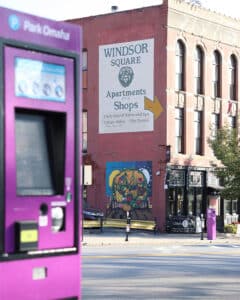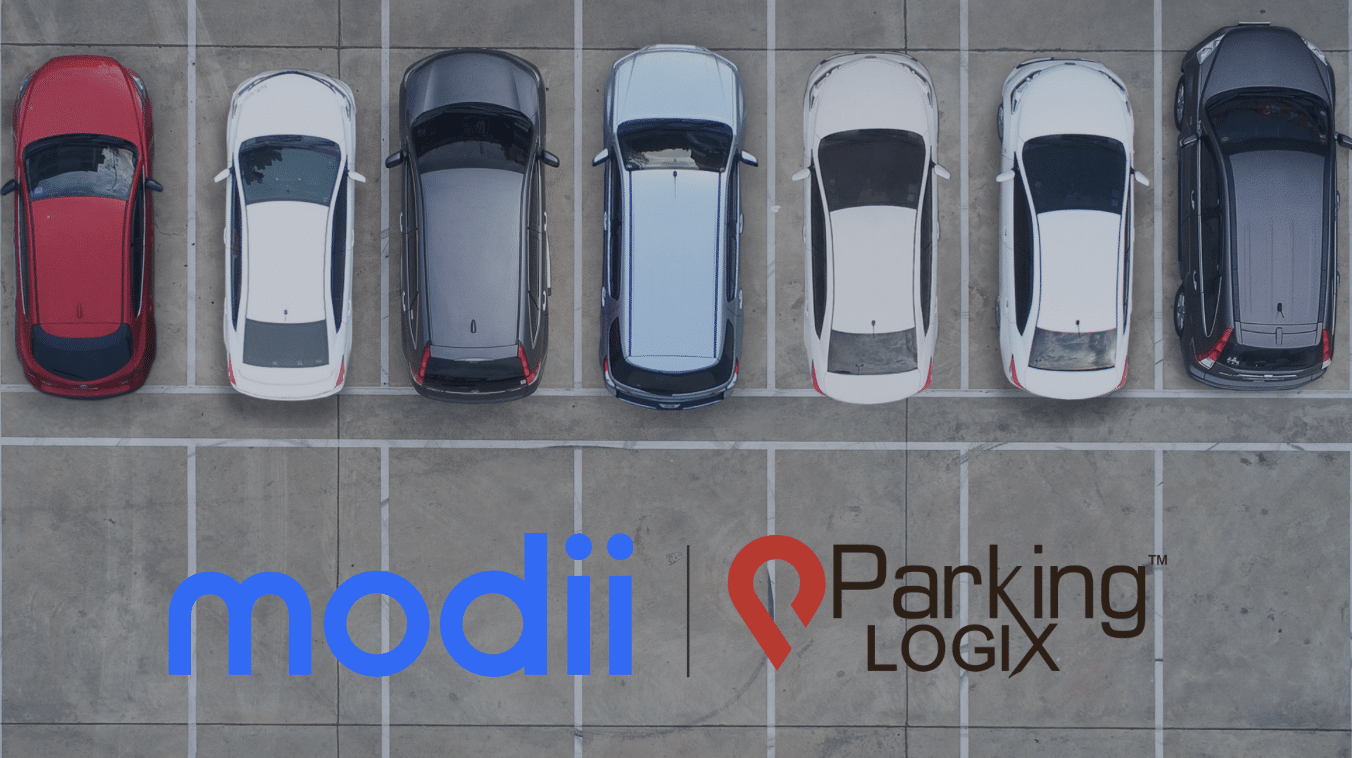
Overcoming Convention

Park Omaha Implements a Parking and Mobility Ecosystem
In our industry, a good parking experience hinges on access and ease of use. At times, providing a positive experience in parking can be difficult and is further impacted when the technology used to manage the comprehensive system is siloed. Traditionally, this was how on-street parking, off-street parking, and mobility applications had been managed in Omaha. To combat the inefficiencies that this conventional system approach created, Park Omaha went on a journey to break down these silos and implement a cohesive “ecosystem” that brings our managed services into one. By doing so, we simplified our equipment and deployed an integrated system designed to be easy for our customers and our staff to use. Our journey continues in an ever-changing environment where the implementation of our ecosystem has made us more flexible to adjust our policies and practices with the data we now systematically analyze.
Why an “Ecosystem”?
The word ecosystem denotes complex systems working together to provide a supported environment where the users benefit from its design. For Park Omaha, our ecosystem was designed to accomplish organizational goals, and provide access to more comprehensive data for our staff and the public. This was done by honing in on how our organization fits into the community, and what role we play in providing services to those that live, work, and play in Omaha. Park Omaha is just one part of a larger system of transportation in our metropolitan area, so with this implementation we needed to consider the following planning exercises to ensure the outcomes would make a lasting impact on our city:
Strategic Plan

- Growing the urban core to increase jobs and residents, develop an active and attractive urban environment, and support business growth.
- Increasing efficiency and cutting costs by minimizing off-street parking while utilizing our existing parking assets and promoting user satisfaction.
- Leading toward a future of success by integrating parking into the transportation system, partnering to accomplish common community goals, and advocating for the city to serve as a guide to ensure future agreements for parking are consistent with these set goals.
One of the long-term goals of this plan was to develop an all-inclusive technology platform that integrates parking and other services, promotes alternative modes of transportation and adopts a progressive/tiered on street paid parking program.
Financial Analysis
Subsequently, Park Omaha completed a financial analysis that resulted in recommendations on the rate structure and programmatic offerings in on- and off-street parking. For the on-street environment, it was evident that greater turnover was needed in some of the most used metered parking areas. A contemplation and modeling of progressive rates was conducted and showed that this may result in greater compliance with parking codes, higher turnover in areas where it is needed, and additional revenue to be put back into the system to be used for economic development. In the off-street environment, an analysis of user groups and rates was completed resulting in recommendations for additional programming for the hybrid worker and continued review of daily and monthly rates in each facility.
Aging Equipment
The final factor that played a large part in Park Omaha’s decision to implement a comprehensive, simplified technological approach to the management of the parking and mobility systems in Omaha was the age, condition, and effectiveness of the equipment that was being used in the system. The single space meters, signage, and access controls that had been in place for a number of years and had limitations that could be overcome by the ecosystem approach being contemplated by our organization.
Planning for Success
To achieve a successful implementation, a project of this nature requires an organization to be very detailed and intentional in its approach. To that end, the planning for Park Omaha’s change to a new ecosystem approach started with the recommendations of the strategic plan and financial analysis mentioned above and concluded with a detailed request for proposals. During the planning phase of this project, pieces of the Project Management Institute’s body of knowledge were employed to gain an accurate understanding of what the needs of the organization were and how they could best be met.
The Project Management Body of Knowledge (PMBOK) was used in the documentation of the project. A charter was written to initiate the formal project and then the work began. There were three key pieces to this documentation: the project management plan, work breakdown structure, and our key deliverable of this phase, the RFP and its specifications.
Project Management Plan
The PMBOK outlines a project management plan (PMP) as a comprehensive document that considers the different “performance domains” vital to a successful project. Within each domain, there are different levels of detail to define a PMP. It is important to choose the appropriate level of detail for each project that you undertake. Each project is different and therefore requires an independent analysis of the detail that is needed in order to be successful. For example, if a project is simple, e.g., updating an already existing website for your organization, you may only need to have a project charter that defines the project and the roles different individuals will perform, and a basic PMP to show the scope of the changes, schedule for performance, and any monetary resources that will be required to accomplish the changes.
However, for a more complex project like this ecosystem, we needed a more substantial plan that included scope, risk assessment, products and deliverables, quality management, a work breakdown structure, project team directory, communication management plan, change register, stakeholder management plan, and resource requirements checklist. The plan itself talks about how the project is going to be performed, not what is going to be done. It outlines the rules that govern the project, so all members of the project team and the sponsors know what to expect. Some of the appendices of the plan were used to guide the work undertaken. One of those appendices was the work breakdown structure (WBS).
Work Breakdown Structure
To build a WBS, each piece of a project must be considered. Park Omaha broke the work down into eight pieces, including municipal code review, rate structure specifics, on-street management, off-street management, curbside and mobility management, marketing, reporting, and communications. Each of these pieces required different resources, detail, and deliverables. Therefore, over a period of three to four weeks, I spent time with each of the different groups in our organization to flesh out all of the considerations for these different areas. I documented these considerations in a Google sheet that I could track and update and that could be viewed by the project team. Conducting brainstorming sessions with the Park Omaha team members ensured that all in the organization were aware of the upcoming changes and had a voice in framing how the project would proceed. This WBS acted as a checklist during the implementation of the project as we went through setting the specifics in the RFP for rates, equipment, reporting, and other operational components. The municipal code changes that would need to be made to facilitate the new system structure were documented and used when writing the amendment to the Omaha Municipal code. Those changes included verbiage regarding rates, tiers, violations, considerations for accessible parking, and removal of language regarding single space meters and the enforcement thereof.
Request for Proposals
Having completed the project management plan and the work breakdown structure early in the project, it was determined that our organization needed to engage a consultant team to assist with the technical details and documentation of the specifications for the RFP process. Specifications were drawn up for a system that includes multispace meters in the garage structures and in the on-street environment, gateless off-street parking management with fixed license plate recognition cameras, electronic variable messaging signage, and a central operating system where all data is housed and integrated to the hardware and enforcement software.
In order to capture the technological complexity of this project the Park Omaha team created one master workflow and four breakouts of that workflow for the on street, off street, immobilization, and loading zone applications. These workflows show the data flowing through the system from the time a parker starts a session to the options for payment or non-payment, then the data flows into a repository and additional actions are defined from there. These workflows were designed as a tool to communicate requirements to the vendors we selected in order to be clear on who was handling what and what the expected outcomes were. Further consideration was made for adding in mobility applications on this central dashboard that would allow for our organization to utilize one system to do the majority of our activity on a day-to-day basis.
The EcoSystem
Omaha received 8 proposals to implement the parking and mobility ecosystem that includes:
- 451 multispace meters broken out into three on street tiers (2+, 3+, and Economy) and 14 meters in the off-street environment to support payment at garages and off street lots.
- 43 Fixed License Plate Recognition Cameras for 6 parking structures and 5 off street lots
- 32 Variable messaging signage installed at the entries and exits of the off-street structures and lots.
- Software components to aggregate data, process and analyze parking sessions, and manage programming of the cameras, meters, and signage throughout the system.
Two of the eight proposals were chosen for the contracting stage of the project. In crafting the contracts for the implementation, integration plans were discussed with four vendors (two existing) in order to realize the outcomes envisioned by the Park Omaha team. It was decided that we would utilize the same payment methods in the on and off-street environments. These payments, coupled with data from the fixed LPR and VMS into the “Park Omaha Dashboard”, would allow for our team to manage payments, access control, monthly parking agreements, occupancy, enforcement, rates, and communications from one system.
With contracts in place, the software work began. The on-street programming started first to tie payments from two mobile applications and the multi space meters into the “Park Omaha Dashboard”. Additional work was started for the off-street environment and installation of the hardware was planned and executed. In addition to payments, enforcement was integrated with some nuance in the way that Park Omaha enforces the on street versus the off-street spaces. With one enforcement provider the on-street enforcement occurs with ambassadors checking license plate information in zones of on street spaces, whereas off street enforcement is conducted by collection of license plates with fixed LPR cameras at the entries and exits of the facilities and lots, checked for quality by the Park Omaha team, and then transmitted to the enforcement provider for issuance of invoicing for those found non-compliant with our stated rates.
The documentation that was discussed above was written into the contracts and discussed at length with each of the providers. During the implementation of the design progress meetings were conducted with the vendor teams. Park Omaha then drew up the final acceptance testing process and reconvened the four vendor teams that worked together to build the system to see the system running end to end. It took a few testing sessions, some persistence, and attention to detail by all parties involved to see all the functionality come to fruition. The build was only the first step though, more work is needed to realize the vision of this EcoSystem.
Early Outcomes, Struggles and Ongoing Analysis
With the effort of our partners and the Park Omaha team, we built the EcoSystem. Like any “EcoSystem” there are many moving pieces. The parking and mobility environment is no different and as such we need some complexity to handle each of those pieces. We have seen the need for continued analysis of the changes we planned and implemented. A few of the early outcomes include more complete data, added efficiency and access to reporting, and an increase in on street revenue. Likewise with substantial change we have seen some struggle in adoption both internally and with our customer base. Finally, for some performance indicators it is just too early to tell.
Outcomes
Data can be powerful if you are able to use it properly. At Park Omaha, one of the key outcomes that we looked for in this project was a more complete data set to analyze how our system is performing and if there are any improvements that can be made in order to provide better service and enhanced management of the resources that we are responsible for. We can already see that by bringing all of our data into a central repository we are able to perform a more comprehensive analysis of our operation. At the outset of this project, we planned for all payment data and parking sessions to be accessible by our staff in one system. This is a contrast to the different data collection methods we previously employed with mobile application data being pulled from one system, coin being collected manually with vague location data, and credit card payments being collected from a third system. The added efficiency of having this all-in-one system saves much needed time and makes it easier to identify errors when they occur.
We have also set up daily, weekly and monthly reporting to send automatically to staff in order to facilitate their work. Reports can be customized, sorted, and scheduled for different durations for transmission to different operational groups.
Finally, increased revenue has been consistently observed in our on-street parking due to a change to progressive rates. Over the past five months we have seen an average increase of approximately 42% from the previous year. This is likely partially due to continued recovery from the COVID-19 pandemic reduction in revenue as we get farther and farther away from the impact of 2020 and 2021, but we can also assume that a portion of this increase is from added payment options, clarity of communication, and ease of use by doing away with time limits and encouraging compliance with payment for on street parking.
Park Omaha has expectations of greater compliance in the months to come as patrons become more familiar with the new regulations in Omaha. Though for now it is too early to say we are seeing a reduction with certainty, as any decrease seen in citations issued from the last five months is likely a result of a recent policy shift to allow for the issuance of warnings for nonpayment of on street parking while education about the new system is being conducted.
Struggles
It may be a bit cliche, but this is where I say “change is hard”. In a short amount of time, we have rolled out a new system. This means staff are not as familiar with how reports are run, equipment is maintained, vehicles show up in our enforcement application, and plates are read by the license plate recognition cameras. It takes some getting used to, that is to be expected. On the public facing side it is much the same. The multispace meters are different, the options for mobile pay are there as well, the transition from prox cards to LPR based off-street access control has its hurdles. As they are all occurring at once we have had to manage communications (though pre planned) as they come. Having completed large changes like this before some are more prepared to handle it than others. In these struggles it has been my duty to ensure both staff and the parking public that we are committed to resolving any issues that come up with a sense of urgency and responsibility. As we work through the struggles, commitment is ever more important, knowing that we will get through them. Thus far we have identified that education and patience are the most effective responses while attention to detail and documentation of any report is also vital to its resolution. These should be standard practices of any municipal organization and are becoming great tools for Park Omaha’s staff as each new day passes.
Conclusion
When I began this article, I wanted to show all of you how Omaha has systematically worked to accomplish the goals set by our organization in the strategic plan and financial analysis we performed. We, at Park Omaha, have done that. We now have a system that brings on street parking and off-street parking into one management system. We will continue to layer in our additional programs for curb management and mobility as time goes on, and hope to partner with other transportation organizations in our area to bring all of our offerings into that “all-inclusive technology application” mentioned in our 2020 strategic plan update. We also have rolled out progressive rates in our on-street environment and early data shows it will help us to do more in our community.
Additionally, it is important to note that the planning and implementation process shown here can be replicated by any organization. The Project Management Institute’s guidelines are out there for all of us to employ. Other organizational tools described in this article are widely available to everyone in this industry. In planning and executing this project I used common tools that were at my disposal. In choosing vendors for this project, we noted that the teams we chose to work with were best for us and for our style of management in Omaha, but those may or may not be the best for other teams in other locations.
Finally, there is a great example here for other municipal parking and mobility organizations. Omaha is not particularly large but we have a unique team of individuals that is willing to think differently about providing services and managing our assets. Our team is small with approximately 50 people total with only 9 internal city staff members working on visioning, planning, and project implementation. With these staff members we have worked hard to find and foster the skills we need in order to be successful. We are dedicated to cross training and pitching in to accomplishing our goals. I say this to encourage others to do the same. With the EcoSystem implementation in particular I encourage others to note that Park Omaha staff planned, communicated, and tested the system. We asked specific questions about how the system is built, and we continue to investigate how the system is working. When we see a problem, we track down why it happened and what must be done to resolve it. Not everyone can do that today, but if you want to, as a municipal entity, you can. We are the owners of our parking and mobility ecosystem and have a responsibility to our community to provide the best services we can. ◆
Hannah R. Adeponu, CAPP, is Assistant Parking and Mobility Manager for Park Omaha.
-
This author does not have any more posts.


Modii and Parking Logix Announce Omni Channel Availability “Know Before You Go!”
Home / IPMI & Member News / Modii and Parking

EnSight Technologies Selected by City of Fort Pierce to Provide Parking Guidance Technology
Home / IPMI & Member News/ EnSight Technologies Selected by

Flash Wins California Energy Commission $5.8M Grant for EV Charger ‘Innovation Lab’ in Oakland
Home / IPMI & Member News / Flash Wins California

How to Eat Your Way Through Columbus
How to Eat Your Way Through Columbus By the team

Modii and Parking Logix Announce Omni Channel Availability “Know Before You Go!”
Home / IPMI & Member News / Modii and Parking

EnSight Technologies Selected by City of Fort Pierce to Provide Parking Guidance Technology
Home / IPMI & Member News/ EnSight Technologies Selected by











